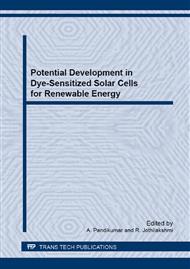[1]
B. O'Regan and M. Gratzel, A low-cost, high-efficiency solar cell based on dye-Sensitized colloidal TiO2 films, Nature 353 (1991) 737-740.
DOI: 10.1038/353737a0
Google Scholar
[2]
J. Nelson, Continuous-time random-walk model of electron transport in nanocrystalline TiO2 electrodes, Phys. Rev. B 59 (1999) 15374-15380.
DOI: 10.1103/physrevb.59.15374
Google Scholar
[3]
A. Solbrand, H. Lindstrom, H. Rensmo, A. Hagfeldt, S.-E. Lindquist and S. Sodergren, Electron transport in the nanostructured TiO2-electrolyte system studied with time-resolved photocurrents, J. Phys. Chem. B 101 (1997) 2514-2518.
DOI: 10.1021/jp962819y
Google Scholar
[4]
S. Ngamsinlapasathian, T. Sreethawong, Y. Suzuki and S. Yoshikawa, Single- and double- layered mesoporous TiO2/P25 TiO2 electrode for dye-sensitized solar cell, Sol. Energy Mater. Sol. Cells 86 (2005) 269-282.
DOI: 10.1016/j.solmat.2004.06.010
Google Scholar
[5]
S. Kambe, S. Nakade, Y. Wada, T. Kitamura and S. Yanagida, Effects of crystal structure, size, shape and surface structural differences on photo-induced electron transport in TiO2 mesoporous electrodes, J. Mater. Chem. 12 (2002) 723-728.
DOI: 10.1039/b105142n
Google Scholar
[6]
N. G. Park, J. van de Lagemaat and A. J. Frank, Comparison of dye-sensitized rutile- and anatase-based TiO2 solar cells, J. Phys. Chem. B 104 (2000) 8989-8994.
DOI: 10.1021/jp994365l
Google Scholar
[7]
G. Li, C. P. Richter, R. L. Milot, L. Cai, C. A. Schmuttenmaer, R. H. Crabtree, G. W. Brudvig and V. S. Batista, Synergistic effect between anatase and rutile TiO2 nanoparticles in dye-sensitized solar cells, Dalton Trans. (2009) 10078-10085.
DOI: 10.1039/b908686b
Google Scholar
[8]
S. Nakade, M. Matsuda, S. Kambe, Y. Saito, T. Kitamura, T. Sakata, Y. Wada, H. Mori and S. Yanagida, Dependence of TiO2 nanoparticle preparation methods and annealing temperature on the efficiency of dye-sensitized solar cells, J. Phys. Chem. B 106 (2002) 10004-10010.
DOI: 10.1021/jp020051d
Google Scholar
[9]
P. Balraju, P. Suresh, M. Kumar, M. S. Roy and G. D. Sharma, Effect of counter electrode, thickness and sintering temperature of TiO2 electrode and TBP addition in electrolyte on photovoltaic performance of dye sensitized solar cell using pyronine G (PYR) dye, J. Photochem. Photobiol., A 206 (2009) 53-63.
DOI: 10.1016/j.jphotochem.2009.05.014
Google Scholar
[10]
K. Hou, B. Tian, F. Li, Z. Bian, D. Zhao and C. Huang, Highly crystallized mesoporous TiO2 films and their applications in dye sensitized solar cells, J. Mater. Chem. 15 (2005) 2414- 2420.
DOI: 10.1039/b417465h
Google Scholar
[11]
L. Lu, R. Li, K. Fan and T. Peng, Effects of annealing conditions on the photoelectrochemical properties of dye-sensitized solar cells made with ZnO nanoparticles, Sol. Energy 84 (2010) 844-853.
DOI: 10.1016/j.solener.2010.02.010
Google Scholar
[12]
G. Kantonis, T. Stergiopoulos, A. P. Katsoulidis, P. J. Pomonis and P. Falaras, Electron dynamics dependence on optimum dye loading for an efficient dye-sensitized solar cell, J. Photochem. Photobiol., A 217 (2011) 236-241.
DOI: 10.1016/j.jphotochem.2010.10.015
Google Scholar
[13]
M. Ansari-Rad, Y. Abdi and E. Arzi, Monte Carlo Random walk simulation of electron transport in dye-sensitized nanocrystalline solar cells: influence of morphology and trap distribution, J. Phys. Chem. C 116 (2012) 3212-3218.
DOI: 10.1021/jp207907b
Google Scholar
[14]
J. A. Anta and V. Morales-Florez, Combined effect of energetic and spatial disorder on the trap-limited electron diffusion coefficient of metal-oxide nanostructures, J. Phys. Chem. C 112 (2008) 10287-10293.
DOI: 10.1021/jp712005k
Google Scholar
[15]
A. J. Frank, N. Kopidakis and J. v. d. Lagemaat, Electrons in nanostructured TiO2 solar cells: transport, recombination and photovoltaic properties, Coord. Chem. Rev. 248 (2004) 1165-1179.
DOI: 10.1016/j.ccr.2004.03.015
Google Scholar
[16]
M. J. Cass, F. L. Qiu, A. B. Walker, A. C. Fisher and L. M. Peter, Influence of grain morphology on electron transport in dye sensitized nanocrystalline solar cells, J. Phys. Chem. B 107 (2002) 113-119.
DOI: 10.1021/jp026798l
Google Scholar
[17]
J. Yu, H. Yu, B. Cheng, M. Zhou and X. Zhao, Enhanced photocatalytic activity of TiO2 powder (P25) by hydrothermal treatment, J. Molecul. Catal. A 253 (2006) 112-118.
DOI: 10.1016/j.molcata.2006.03.021
Google Scholar
[18]
Q. Wang, S. Ito, M. Gratzel, F. Fabregat-Santiago, I. Mora-Sere, J. Bisquert, T. Bessho and H. Imai, Characteristics of high efficiency dye-sensitized solar cells, J. Phys. Chem. B 110 (2006) 25210-25221.
DOI: 10.1021/jp064256o
Google Scholar
[19]
J. Bisquert, F. Fabregat-Santiago, I. n. Mora-Sero, G. Garcia-Belmonte and S. Gimenez, Electron lifetime in dye-sensitized solar cells: theory and interpretation of measurements, J. Phys. Chem. C 113 (2009) 17278-17290.
DOI: 10.1021/jp9037649
Google Scholar
[20]
H. K. Dunn and L. M. Peter, How efficient is electron collection in dye-sensitized solar cells? comparison of different dynamic methods for the determination of the electron diffusion length, J. Phys. Chem. C 113 (2009) 4726-4731.
DOI: 10.1021/jp810884q
Google Scholar
[21]
K. Miettunen, J. Halme, M. Toivola and P. Lund, Initial performance of dye solar cells on stainless steel substrates, J. Phys. Chem. C 112 (2008) 4011-4017.
DOI: 10.1021/jp7112957
Google Scholar



